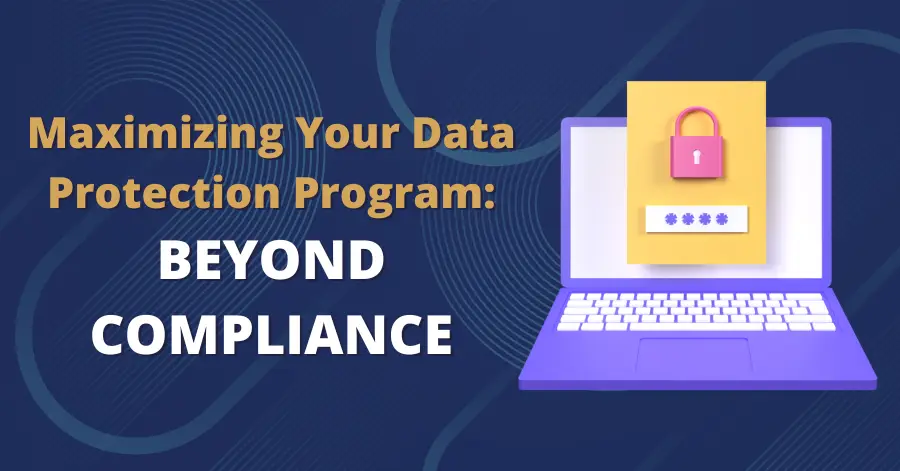Maximizing Your Data Protection Program: Beyond Compliance


Achieving privacy compliance is a non-negotiable first step for any business. But it’s just the beginning.
Businesses building trust with customers and partners must go beyond simple legal compliance. A more comprehensive data protection strategy provides extra layers of security and shows potential contacts that you take privacy very seriously. With customers listing trust as a critical factor in who they choose to do business with, showing everyone that you can be trusted will go a long way.
The Shift from Compliance to Privacy-Centric Business Practices
So, how do you shift from checking things off a legal list to a broader, more respectful approach to handling personal data? The fine details will vary depending on the exact nature of your business and the data you use. However, regardless of your industry, there are a few tasks you can prioritize to take your data protection program to the next level.
1. Maintain an Up-to-Date Data Inventory
Businesses that comply with data regulations typically maintain some form of data inventory to track how and where personal information is collected, stored, and used. However, data processes evolve, and so must your data inventory.
A well-managed data inventory helps businesses keep track of their data sources, usage, and flows. It should include all data types collected, where they are stored, who has access to them (including third-party vendors), and how they are shared. Updating your data inventory frequently allows you to reduce unnecessary duplication, streamline information flows, and simplify data management processes.
For simpler updates, automation can save your company a lot of time and help to identify potential risks. More detailed updates will likely require human involvement. But regardless of your preferred method, reviewing and updating your data inventory regularly is a must.
2. Prioritize Data Minimization
With the role data plays in modern marketing, it’s all too easy to focus on collecting more data than is necessary. Customers don’t appreciate that, and they demonstrate this by abandoning forms that feel invasive. Demanding too much data feels intrusive to consumers, and places them at a higher potential risk in the event of a data breach. Privacy-conscious businesses should instead practice data minimization and only collect what is necessary.
Simply defined, data minimization is the practice of collecting only what data you need for a particular task. (For example, a promotion for birthday bonuses will obviously require a customer’s birthdate, but not their shirt size.) This might sound restrictive until you realize that most companies only use about half the customer data they collect and retain. That unused data occupies valuable space in your records—space that could go toward data that actively contributes to marketing plans. Data minimization also helps build trust with customers who may be wary about handing over too much personal information.
3. Take Advantage of Automation
As your company grows, so does the complexity of complying with privacy regulations and responding to data subject requests. You could hire twice as many employees to handle every minute detail. Or you could automate the less important tasks.
Automated workflows can streamline the finer details of privacy audits, DSARs, and similar processes. The potential for improving response times is obvious. But automation doesn’t just make tasks go faster. Automation enables continuous monitoring and instant access to information at every step of the process. Not only does this let you keep up with how things are going, but it also significantly reduces your risk of errors.

4. Give Consumers Control Over Their Own Data
Today’s consumers are inundated with marketing messages from multiple brands across various platforms. The oversaturation of marketing content has led to what is known as “marketing fatigue,” causing many customers to disengage or block communications altogether.
To avoid alienating your audience, give consumers more control over how their data is used and how they receive communications. Implementing a customer-facing preference center can be a game-changer for building trust. Rather than presenting a simple “unsubscribe” option, a preference center allows users to select what kinds of messages they want to receive and how frequently they prefer to be contacted. This ensures that the communications they receive are relevant and welcomed, and builds trust with your customers.
5. Develop a Comprehensive Privacy Training Program
Privacy and data protection are not just the responsibility of the legal or IT department—they must be part of the company culture. Ongoing privacy training needs to include all your employees. But as important as formal training is, don’t stop there. Encourage a culture of privacy through informal channels like privacy-focused chat groups or newsletters. You can also consider attending a privacy conference as a company. Whatever you choose, ensure that your team is aware of and passionate about data protection.
Conclusion: Building Trust Through Data Protection
Maximizing your data protection program means going beyond compliance and embedding privacy into your organization’s DNA. By maintaining an up-to-date data inventory, embracing data minimization, automating busywork, giving consumers control over their data, and providing continuous privacy education, your business can become a leader in data protection.
Ready to improve your approach to data privacy? Contact us today to get started.





